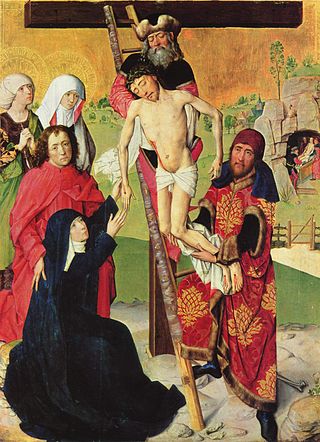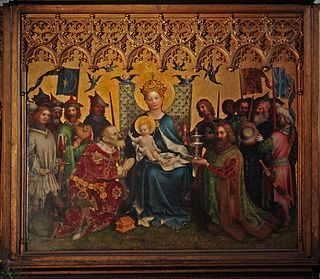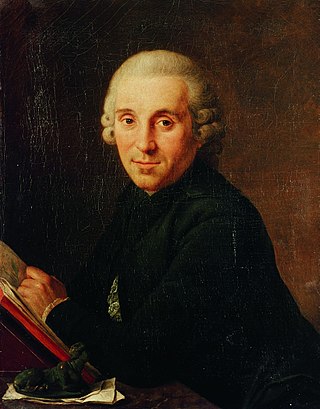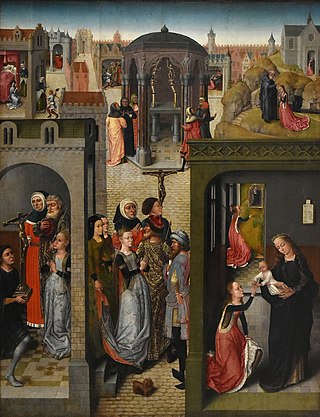
Hans von Aachen was a German painter who was one of the leading representatives of Northern Mannerism.

Stefan Lochner was a German painter working in the late International Gothic period. His paintings combine that era's tendency toward long flowing lines and brilliant colours with the realism, virtuoso surface textures and innovative iconography of the early Northern Renaissance. Based in Cologne, a commercial and artistic hub of northern Europe, Lochner was one of the most important German painters before Albrecht Dürer. Extant works include single-panel oil paintings, devotional polyptychs and illuminated manuscripts, which often feature fanciful and blue-winged angels. Today some thirty-seven individual panels are attributed to him with confidence.

The Wallraf–Richartz Museum is an art museum in Cologne, Germany, with a collection of fine art from the medieval period to the early twentieth century. It is one of the three major museums in Cologne.

Jacob Claesz van Utrecht, also named by his signature Jacobus Traiectensis was a Flemish early Renaissance painter who worked in Antwerp and Lübeck.

Joos van Cleve was a leading painter active in Antwerp from his arrival there around 1511 until his death in 1540 or 1541. Within Dutch and Flemish Renaissance painting, he combines the traditional techniques of Early Netherlandish painting with influences of more contemporary Renaissance painting styles.

The Master of the Life of the Virgin, in German the Meister des Marienlebens,, is the pseudonym given to a late Gothic German painter working in Cologne. He can also be known as the Master of Wilten, or Johann van Duyren, an identification not universally accepted.

Wilhelm of Herle was a painter.

The Master of the Saint Bartholomew Altarpiece was an Early Netherlandish painter active in Germany, mostly Cologne, between 1475/1480 and 1510. Despite his anonymity, he is one of the most recognizable artists of the early Renaissance period in German art.

Colijn de Coter was an early Netherlandish painter who produced mainly altarpieces. He worked primarily in Brussels and Antwerp. His name was sometimes given as Colijn van Brusele, indicating that he hailed from Brussels or at least that he lived there most of his active life. He also signed several paintings with Coliin de Coter pinxit me in Brabancia Bruselle.

The term Cologne School of Painting was first applied in the 19th century to describe old German paintings generally. It subsequently came to refer more specifically to painters who had their workshops in medieval Cologne and the lower-Rhine region from about 1300 to 1550.

The Master of the Antwerp Adoration was a Flemish painter in the style of Antwerp Mannerism, whose compositions are typically filled with agitated figures in exotic, extravagant clothes. His notname is from a triptych showing the Adoration of the Magi, acquired by the Antwerp Museum of Fine Arts.

The notname Master of the Aachen Altar is given to an anonymous late gothic painter active in Cologne between 1495 and 1520 or 1480 and 1520, named for his master work, the Aachen Altar triptych owned by the Aachen Cathedral Treasury. Along with the Master of St Severin and the Master of the legend of St. Ursula he is part of a group of painters who were active in Cologne at the beginning of the sixteenth century and were Cologne's last significant practitioners of late gothic painting.

Ferdinand Franz Wallraf was a German botanist, mathematician, theologian, art collector and Roman Catholic priest. His collection formed the founding nucleus of the Wallraf–Richartz Museum.

The Master of the Legend of Saint Catherine is the notname for an unknown late 15th century Early Netherlandish painter. He was named after a painting with Scenes from the Legend of Saint Catherine, now kept in the Royal Museums of Fine Arts of Belgium. He was active between c. 1470 and c. 1500, probably around Brussels.

Johann Anton Alban Ramboux was a German painter and lithographer.

Jacques de l'Ange or the Monogrammist JAD was a Flemish painter and draughtsman known for his genre scenes and history paintings executed in a Caravaggesque style. The artist was only rediscovered in the mid-1990s as his work was previously attributed to other Northern Caravaggists and in particular the Utrecht School Caravaggists or Flemish Carravagists.

The Master of the Karlsruhe Passion is the notname of a German painter of the late Gothic period active in the Upper Rhine. Very influential on other painters in the region, he may be identified with the Strasbourg painter Hans Hirtz. He is named after his main work, the Karlsruhe Passion, though he may also have been the artist behind the murals in the former Dominican church in Strasbourg, only known through two 17th century copies.

Johann Heinrich Richartz was a German businessman and patron of the arts, best known as the main funder of the Wallraf-Richartz-Museum.

The Master of the Wasservass Calvary is the notname for a painter active in Cologne between 1415 and 1435. He is relatively unusual in Cologne art of his time, owing more to Burgundian manuscript illuminating and Early Netherlandish painting of the time.

The Master of the Legend of Saint Bruno is the "notname" of an anonymous Gothic painter who was active in Cologne in the late 15th century. He is best known for the cycle of paintings on canvas produced for Cologne Charterhouse after which he is named.






















